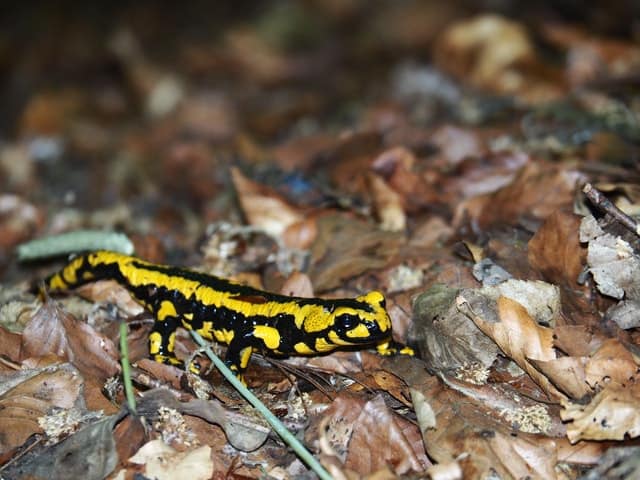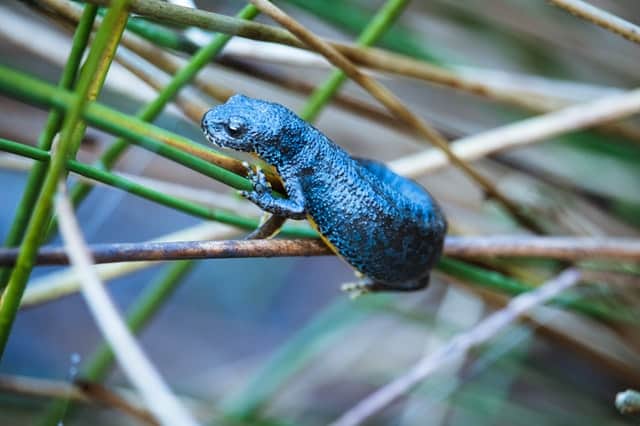All Salamander species produce a poisonous secretion
that emits deadly toxins from the specialized epidermal gland (the outer layer of skin). Due to this, they can pose a threat to humans and animals.
Salamanders are poisonous (you have to ingest their poison), not venomous (bites or stings you). Salamanders can be handled, do wash your hands before consuming foods or making contact with eyes or mouth and other areas of the body.

Table of Contents
Are Salamanders poisonous to humans? Can they kill you?
Yes, the poison released from Salamander is deadly. It is known that the poison has no cure, but for this to be deadly, you will have to ingest the Salamander or its toxins;
this also means if you touch it and consume something, you will feel sick and numbing in the muscles, and it will affect the respiratory muscles you will find it hard to breathe. You should seek medical attention.
All Salamanders
can produce poison, and toxicity varies
widely between species though many more
times than not, they won’t secrete it
unless they feel threatened. They release toxins through their skins; it’s best to wash your hands and avoid contact with your eyes and mouth, especially when you have small children around. It’s a good idea to wear gloves when handling the little fellas.
Can You Get Diseases from Salamanders?
Salamanders are classed as Amphibians and can carry salmonella. A CDC(Center for Disease Control and Prevention) has an article on their website about the dangers of salmonella;
After touching a Salamander, wash your hands with Anti-bacterial soap.
Salamanders Poisonous to Touch?
Salamanders release toxins from the skin when they feel anxious or threatened. You can handle them safely if you are gentle. Experts say the poison is most deadly when ingested. It is a good idea to wash your hands after handling a Salamander or, if unsure, wear gloves
Salamander Poisoning Symptoms
- tingling – feeling of pins and needles
- numbness to the face and other parts of the body,
- vomiting – the body will try to reject the poison
- diarrhea – urge to need toilet
- abdominal pain – pain in the abdominal area, discomforts.
If you suffer from any of the symptoms above or feel unwell, visit a hospital or poison helpline.
Are salamanders Poisonous to Dogs?
Salamanders can be poisonous to dogs because Salamanders release toxins into their skins. It’s pretty harmful if it’s ingested, and generally, dogs tend to use their tongues to explore. Salamanders are somewhat fearful; that’s when they are most likely to release poison onto their skins. One lick of the Salamanders from a dog could cause the dog serious harm. If your dog has come in contact with a Salamander, seek advice from a vet or a qualified animal expert.
If you are walking your dog in the woods, keep a close eye on your dog, Salamanders are generally found in wooded habitats in small ponds, hidden in under logs, and mainly in dark, moist areas.

Can a salamander kill a dog?
Salamanders are not venomous (if it bites you). They are poisonous (you bite or ingest them). To kill a dog, the dog will have to eat the Salamander or consume the poison. Salamander will release venom if it feels the predator or any other species is a threat to it. But in general, they would run away before encountering a dog.
Are salamanders poisonous to cats?
Yes, cats can be poisoned by salamanders. Toxicity levels in salamanders range from moderate to deadly
They discharge these toxins through their skin.
As cats are natural predators, they will make the Salamander feel a little intimidated; that is when the Salamanders would release their toxins. Cats are known to eat predators, but if a cat eats a salamander, the cat will most certainly die.
Are Tiger Salamanders poisonous?
Tiger Salamanders tails are poisonous
Tiger Salamanders secrete a painful
poison from their tail. It’s not deadly.
Red Salamander poisonous
Red Salamanders look harmless and are if they are handled with care. However, they can release toxins from their skin if this toxin ingested will cause serious harm like
Should you Kill Salamanders?
No, never kill a Salamander. They are harmless and shy creatures and pose no threat. If provoked, they can release a toxin thru the epidermal gland from the skin. But you will have to eat it or ingest its toxins for any harm to be done to yourself.
The best thing to do is to capture it in a plastic container with a bit of water to keep it moist and release it into the wild, preferably near a pond or lake.

What Happens if You Eat a Salamander?
Eating a Salamander will make you seriously ill. And will kill you! You should avoid eating Salamander because of the poison they produce. it is known that salamanders and newts are toxic; Salamander and newts release tetrodotoxin (TTN)
Tetrodotoxin causes nerves to muscles and causes an expanding loss of motion of the body’s muscles. Tetrodotoxin harming can be deadly. More info on Tetrodontin can be found here.
